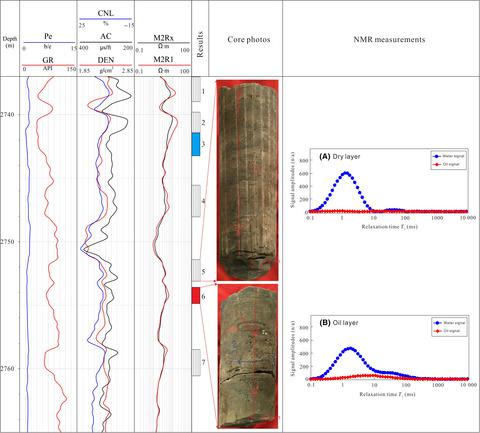当前位置:
X-MOL 学术
›
Energy Sci. Eng.
›
论文详情
Our official English website, www.x-mol.net, welcomes your
feedback! (Note: you will need to create a separate account there.)
Effect of pore structure on oil‐bearing property in the third member of Paleogene Funing Formation in Subei Basin, East China
Energy Science & Engineering ( IF 3.5 ) Pub Date : 2020-02-25 , DOI: 10.1002/ese3.657 Xiaoping Liu 1, 2 , Yuqiang Xie 2 , Honglin Shu 3 , Xuechun Fan 2 , Gaocheng Wang 3 , Yufeng Luo 3 , Xiaoqiang Ma 4 , Ziqiang Qin 5
Energy Science & Engineering ( IF 3.5 ) Pub Date : 2020-02-25 , DOI: 10.1002/ese3.657 Xiaoping Liu 1, 2 , Yuqiang Xie 2 , Honglin Shu 3 , Xuechun Fan 2 , Gaocheng Wang 3 , Yufeng Luo 3 , Xiaoqiang Ma 4 , Ziqiang Qin 5
Affiliation

|
Mercury injection capillary pressure (MICP) tests, nuclear magnetic resonance (NMR), (fluorescence) thin section, X‐ray diffraction (XRD), and scanning electron microscope (SEM) analyses were used to describe the size and distribution of entire pore‐throat structures in the sandstones of the E1f3 (the third member of Paleogene Funing Formation) in the Subei Basin. The lithologies of E1f3 in the Subei Basin are mainly dark‐gray, very fine‐grained sandstones and siltstones, interbedded with dark mudstones. The pore systems predominantly feature secondary intergranular and intragranular dissolution pores, micropores coexisting with minor amounts of intergranular pores, and microfractures. The high threshold pressure and bulk volume of irreducible fluids values and the significant variation in the NMR and MICP parameters indicate that the E1f3 reservoirs are characterized by complex and heterogeneous microscopic pore structures. Microscopic pore‐throat parameters are linked with macroscopic properties through the reservoir quality index (RQI). The NMR T2 (transverse time relaxation) spectrum is unimodal or bimodal but with weak right peaks, indicating the rarity of large intergranular pores. However, large‐scale pore throats, though only account for a minor part of the total pore volume, significantly contribute to the total permeability. The abundance of small‐scale pore‐throat systems (short T2 components) results in high irreducible water content. Therefore, the oil saturation in E1f3 sandstones is low, and the pore structure, especially the number of micropores, determines the oil‐bearing property. Oil primarily occurs in the intragranular dissolution pores with minor amounts occurring in the large intergranular pores. Most of the micropores are bound by capillary water. The sandstones with chlorite clay minerals tend to be oil‐wet and have high oil‐bearing potential, while the abundance of detrital clay or illite contributes to a low oil‐bearing grade. The combination of core and microscopic observations and the MICP and NMR analyses have allowed the determination of the pore structure characteristics and their coupling effects on oil‐bearing property.
中文翻译:

华北苏北盆地古近纪富宁组第三段孔隙结构对含油性的影响
使用汞注入毛细管压力(MICP)测试,核磁共振(NMR),(荧光)薄片,X射线衍射(XRD)和扫描电子显微镜(SEM)分析来描述整个孔的大小和分布苏北盆地E 1 f 3(古近纪阜宁组第三段)砂岩中的喉构造。E 1 f 3的岩性苏北盆地主要为深灰色,细粒砂岩和粉砂岩,中间夹有深色泥岩。孔系统主要具有次生的粒间和粒内溶解孔,与少量粒间孔共存的微孔以及微裂缝。高阈值压力和不可还原流体的体积体积值以及NMR和MICP参数的显着变化表明,E 1 f 3储层的特征是复杂且非均质的微观孔隙结构。微观孔喉参数通过储层质量指数(RQI)与宏观特性联系在一起。NMR T 2(横向时间弛豫)光谱为单峰或双峰,但右峰较弱,表明大的晶间孔稀少。但是,大型孔喉虽然仅占总孔体积的一小部分,但对总渗透率却有很大贡献。小规模的孔喉系统(短的T 2组分)的丰富性导致高的不可还原水含量。因此,E 1 f 3中的油饱和度砂岩含量低,孔隙结构,尤其是微孔的数量决定了含油性。油主要存在于颗粒内溶解孔中,少量存在于较大的颗粒间孔中。大多数微孔被毛细管水束缚。含有绿泥石粘土矿物的砂岩往往是油湿的,并且具有较高的含油潜力,而大量的碎屑粘土或伊利石则导致含油等级较低。岩心和微观观测以及MICP和NMR分析的结合使得可以确定孔结构特征及其对含油性的耦合作用。
更新日期:2020-02-25
中文翻译:

华北苏北盆地古近纪富宁组第三段孔隙结构对含油性的影响
使用汞注入毛细管压力(MICP)测试,核磁共振(NMR),(荧光)薄片,X射线衍射(XRD)和扫描电子显微镜(SEM)分析来描述整个孔的大小和分布苏北盆地E 1 f 3(古近纪阜宁组第三段)砂岩中的喉构造。E 1 f 3的岩性苏北盆地主要为深灰色,细粒砂岩和粉砂岩,中间夹有深色泥岩。孔系统主要具有次生的粒间和粒内溶解孔,与少量粒间孔共存的微孔以及微裂缝。高阈值压力和不可还原流体的体积体积值以及NMR和MICP参数的显着变化表明,E 1 f 3储层的特征是复杂且非均质的微观孔隙结构。微观孔喉参数通过储层质量指数(RQI)与宏观特性联系在一起。NMR T 2(横向时间弛豫)光谱为单峰或双峰,但右峰较弱,表明大的晶间孔稀少。但是,大型孔喉虽然仅占总孔体积的一小部分,但对总渗透率却有很大贡献。小规模的孔喉系统(短的T 2组分)的丰富性导致高的不可还原水含量。因此,E 1 f 3中的油饱和度砂岩含量低,孔隙结构,尤其是微孔的数量决定了含油性。油主要存在于颗粒内溶解孔中,少量存在于较大的颗粒间孔中。大多数微孔被毛细管水束缚。含有绿泥石粘土矿物的砂岩往往是油湿的,并且具有较高的含油潜力,而大量的碎屑粘土或伊利石则导致含油等级较低。岩心和微观观测以及MICP和NMR分析的结合使得可以确定孔结构特征及其对含油性的耦合作用。











































 京公网安备 11010802027423号
京公网安备 11010802027423号